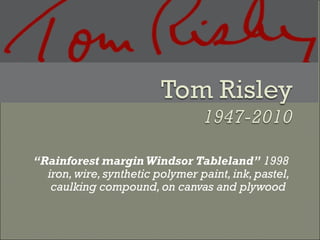
Tom risley presentation03
- 1. “Rainforest margin Windsor Tableland” 1998 iron, wire, synthetic polymer paint, ink, pastel, caulking compound, on canvas and plywood
- 3. simple compositions that were aesthetically pleasing to the eye combined the art form of painting and sculpture. Art held“spiritual essence” (Risley, Art Monthly 2010) that reflected the Australian culture and landscape his “intellectual engagement with art is driven by an intuitive feel for materials and composition.” (Rankin, 2005)
- 4. gained his creative skill and love of art form from his father Noel who was also a sculptor and has been described as Risley’s greatest mentor. As a child Risley spent much of his day collecting and scouring around his neighbourhood The trade skills gained through his early years enabled Risley to have the technical approach to his artwork in the future. Risley’s life skills and passion of collecting and scavenging paved the way for his unique material choice, technique and art form.
- 5. grown up in the era just as society was coming out of the great depression. The ideologies and values at the time reflected the idea of no wastage, and valued used objects that could evolve This domestic and temporary social construction at the time would have shaped Risley’s thinking and encouraged his love and fascination with discarded material. greatest contributing factor and defining point to Risley’s artwork.
- 6. Interpretations of still life work which reflected the knowledge and pre-existing experimentation by the modernist Picasso, Braque and Gris. “Tablet 2005” Tom Risley
- 7. “Still life” Pablo Picasso “Fathers day still life 1987” Tom Risley
- 8. “Still Life study 17” Tom Risley “Still Life” Juan Gris
- 9. “La Pipe” Georges Braque “Family Crest with Graters 2006” Tom Risley
- 10. At this time the art world was evolving from expressionism, surrealism, cubism into the new age of Pop art, the DADA, and minimalism. His mark making resembled the painterly expression of artists like Rothko, Rauschenberg with his use of dormant material, with the Australian colour and essence of a Fred Williams landscape.
- 11. “Still Life 3” Tom Risley Mark Rothko
- 12. He progressed into landscape but continued to incorporate found objects to reflect the culture and character of a specific landscape or place. “Riverbed” Fred Williams
- 13. “Still life with mackeral and oysters” Tom Risley “Lotus 1 2008” Robert Rauschenberg
- 14. he explored and broke the conventions of still life by deconstructing the landscape. He brought found objects from the landscape he would portray and incorporate the material into the artwork. “ rather a combination of ideas, well used technical skills and his ‘intuitive engagement’ with his materials.” (Martin-Chew, 2008)
- 15. Several years ago this would not have been accepted as art in society and certainly not gallery material. Art has developed through the age of the depression, the dominance of the pop culture, then our 21st centaury exploration into recycling to counteract our ‘excessive’ lifestyle Risley’s work has become accepted into art and has become inspirational to contemporary artists.
- 16. “Rainforest margin Windsor Tableland 1998” Tom Risley iron, wire, synthetic polymer paint, ink, pastel, caulking compound, on canvas and plywood.
- 17. complete cohesive landscape that demonstrates the technical skills, knowledge and abilities of Risley. Risley has adhered to the placement and orientation of standard landscape painting He also interpreted the traditional code of dividing the landscape into thirds horizontally
- 18. specified this layout so the viewer does not read the work as a singular vision but to delve into the art further and discover an emotive, multi-dimensional vision. portrays the landscape in a unique way not to just represent the place physically but to try and “evoke a memory or feeling, and emotive encounter with the landscape…”(Tonkin, 2005, p.11).
- 19. found objects within this piece were once part of the landscape The objects have now become a tool within Risley’s work to communicate to the viewer a captured moment or memory from the landscape. worked each piece until it works aesthetically and balanced and is bound together with concept.
- 20. The found objects demonstrate the changing vegetation. He has placed each object using space and shape to balance and capture the essence of the bush. mark making resembles the odd harshness of the bush environment brush strokes are rough and appear to be at random, using limited palette and layering he reflects the colours and appearance of the Australian bush
- 21. Risley has interpreted in his own way the familiar traditional codes and conventions of a landscape to communicate his concept. The simple format, subject matter and materials are all familiar to the viewer and provide a pleasant escape into a landscape through emotions and memories. He has explored and portrayed a unique love of the Australian landscape and strived to bring the emotions and memories of his experiences to the audience.
- 22. Martin-Chew, L 2010, Obituary, Art Monthly 2010, Iss. 234, viewed 26 November 2010, < http://www.artmonthly.org.au/artnotes.asp?aID=29&issueNumber=234 > Mayo, K 2005, Tom Risley, Cairns Regional Gallery, Arts Nexus 2005, viewed 26 November 2010, < http://www.artsnexus.com.au/phpBB2/viewtopic.php?t=3 > Reid, S 2005, Tom Risley, Cairns Regional Gallery, Arts Nexus 2005, viewed 26 November 2010, < http://www.artsnexus.com.au/phpBB2/viewtopic.php?t=11 > Risley, T 2010, Works, City of Cairns.com, viewed 29 November 2010 < http://www.tomrisleyartist.com/index > 20th Century, Wikipedia 2010, viewed 29 November 2010, < http://en.wikipedia.org/wiki/20th_century > Tonkin, S 2005, Tom Risley Bibliography, Cairns Regional Gallery, Cairns.